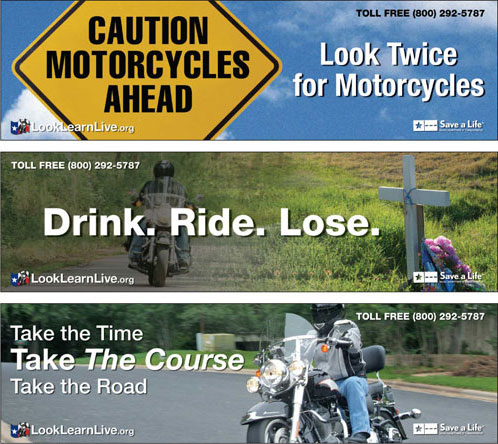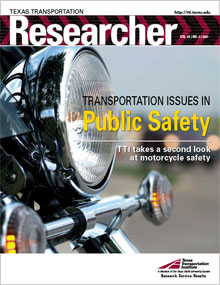 In 1969, a man and his motorcycle went in search of America. The classic film Easy Rider featured actor Peter Fonda, his “Captain America” chopper and more than a sprinkling of alternative culture. Years later, riders inspired by the film are facing challenges that neither cinema nor celebrities talked about much back then. Motorcycling has never been more popular than it is today—and it’s never faced tougher times.
In 1969, a man and his motorcycle went in search of America. The classic film Easy Rider featured actor Peter Fonda, his “Captain America” chopper and more than a sprinkling of alternative culture. Years later, riders inspired by the film are facing challenges that neither cinema nor celebrities talked about much back then. Motorcycling has never been more popular than it is today—and it’s never faced tougher times.

Nationally, motorcycle deaths are up for the ninth year in a row, totaling more than 4,810 in 2006. While they only comprise a small fraction of road users, motorcyclists now account for 11 percent of all traffic fatalities. Preliminary 2006 data from the National Highway Traffic Safety Administration shows that every category of driving fatalities has decreased compared to last year—except for one: motorcycles.
Texas has one of the largest motorcycling populations in the United States and more than its share of fatal motorcycle crashes. According to Fatality Analysis Reporting System (FARS) data, 360 motorcyclists were killed in Texas in 2005, a 24 percent increase in fatalities over the previous year.
To address an alarming upward trend in motorcycling fatalities, the Texas Department of Transportation (TxDOT) teamed with the Texas Department of Public Safety (DPS) and the Texas Transportation Institute (TTI) to develop a new statewide motorcycle safety awareness campaign.
“We are pleased to be working with TTI in their efforts to create messages to inform both riders and car drivers on ways to improve motorcycle safety and ultimately lower rider deaths and injuries,” says Clif Burdette, coordinator for DPS Motorcycle Safety Unit. “The materials will address the importance of getting riders properly trained, driver awareness of motorcycles, as well as the dangers of riding impaired. It was in the early 1990s that the existing materials were produced, so we look forward to having updated brochures and billboards to get the word out about motorcycle safety and help reduce motorcycle-related crashes, injuries and fatalities in Texas.”
TTI Associate Research Scientist Patricia Turner leads TTI’s project to develop the new motorcycle safety public awareness campaign.
“Because no motorcycle safety materials have been developed in Texas since the early 1990s, we knew we needed a comprehensive motorcycle safety public awareness program,” says Turner.
Take a look at the problem
Texas in 2005*:
- The state has one of the largest motorcycle populations in the country.
- Motorcycle-related deaths jump 25 percent over the previous year.
- Registrations grow by 15 percent (a measure of riding popularity).
- Forty-two percent of riders killed in crashes test positive for alcohol.
- Nearly 60 percent of riders involved in fatal crashes were riding without a helmet.
* NHTSA preliminary Fatality Analysis Reporting System data
Nationally in 2006**:
- Total traffic deaths drop to their lowest level in five years; motorcycle rider deaths are up for the ninth consecutive year. They now account for 11 percent of all traffic fatalities, exceeding even pedestrian deaths for the first time in more than 30 years.
** NHTSA July 2006 “Traffic Safety Annual Assessment—a preview”
Take a look at the Texas solution
Research conducted at TTI and elsewhere shows that rider inexperience, alcohol and drugs, speeding and driver and rider inattention are key factors in crashes that result in fatalities for motorcyclists. New safety campaign materials have been tailored to address these factors.
Structured around a new “Look. Learn. Live.” logo, the campaign includes a new Web site and several brochures. Each brochure focuses on a different topic, including safe driving practices necessary for avoiding injuries to motorcyclists (Look), general tips about safe motorcycling (Learn) and information about riding impaired (Live). The goal of the motorist awareness brochure is to let drivers know how hard it can be to see a motorcycle and to detail some of the special challenges motorcyclists face, like bad weather and road conditions. A simple puddle can spell disaster for a motorcycle.
The brochure series accompanies a comprehensive new Web site that will cover a host of related themes and serve as a central clearinghouse in Texas for information motorcycle enthusiasts need, like information about The Course for Motorcycle Riders and where to take it, safety tips and links to other resources.
As the statewide motorcycle safety campaign rolls out in the fall of 2007. Texans will see new brochures, a Web site with a little “motorcycle attitude” mixed in with safety messages and public service announcements (PSA). They may even hear a radio PSA as they pass a billboard that displays a motorcycle safety message.
“Someone dies nearly every day riding a motorcycle in Texas,” says Carlos Lopez, director of TxDOT’s Traffic Operations Division. “More than 90 percent of crashes involving motorcycles results in death, or some level of injury, to the motorcyclist. We are reminding drivers to be on the lookout for motorcyclists, especially at intersections where many crashes occur. With the growing popularity of motorcycling, it is more important than ever for drivers to share the road with motorcyclists. Educating both motorcycle riders and vehicle drivers is essential to improving motorcycle safety and saving lives.”

